Samsung Portable SSD T1 Review
by Ganesh T S on January 20, 2015 10:00 AM ESTStorage Benchmarks
Synthetic Benchmarks - ATTO and Crystal DiskMark
Samsung claims read/write speeds of 450 MBps, and these are backed up by the ATTO benchmarks provided below. Unfortunately, these access traces are not very common in real-life scenarios.
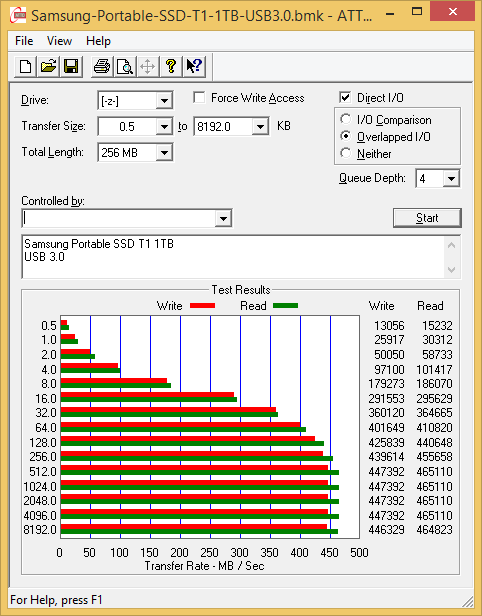
CrystalDiskMark, despite being a canned benchmark, provides a better estimate of the performance range with a selected set of numbers. As evident from the screenshot below, the performance can dip to as low as 26 MBps for 4K accesses at very low queue-depths. It can already be seen from the two benchmarks that enabling encryption doesn't alter the transfer rates at all.
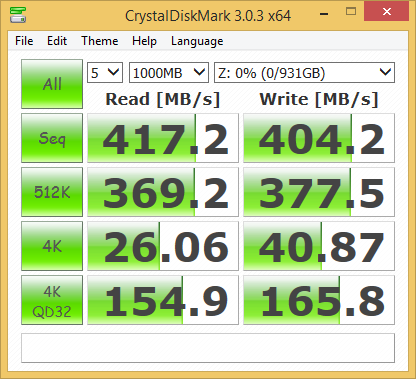
Benchmarks - robocopy and PCMark 8 Storage Bench
Our testing methodology for DAS units also takes into consideration the usual use-case for such devices. The most common usage scenario is transfer of large amounts of photos and videos to and from the unit. The minor usage scenario is importing files directly off the DAS into a multimedia editing program such as Adobe Photoshop.
In order to tackle the first use-case, we created three test folders with the following characteristics:
- Photos: 15.6 GB collection of 4320 photos (RAW as well as JPEGs) in 61 sub-folders
- Videos: 16.1 GB collection of 244 videos (MP4 as well as MOVs) in 6 sub-folders
- BR: 10.7 GB Blu-ray folder structure of the IDT Benchmark Blu-ray (the same that we use in our robocopy tests for NAS systems)





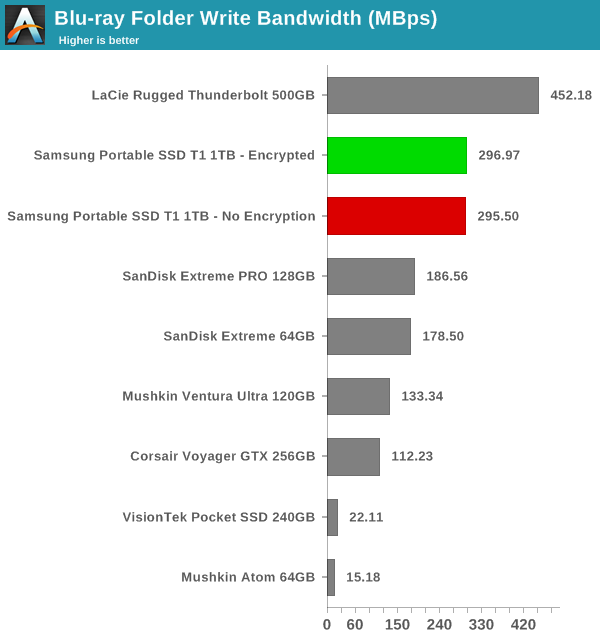
For the second use-case, we take advantage of PC Mark 8's storage bench. The storage workload involves games as well as multimedia editing applications. The command line version allows us to cherry-pick storage traces to run on a target drive. We chose the following traces.
- Adobe Photoshop (Light)
- Adobe Photoshop (Heavy)
- Adobe After Effects
- Adobe Illustrator
Usually, PC Mark 8 reports time to complete the trace, but the detailed log report has the read and write bandwidth figures which we present in our performance graphs. Note that the bandwidth number reported in the results don't involve idle time compression. Results might appear low, but that is part of the workload characteristic. Note that the same testbed is being used for all DAS units. Therefore, comparing the numbers for each trace should be possible across different DAS units.


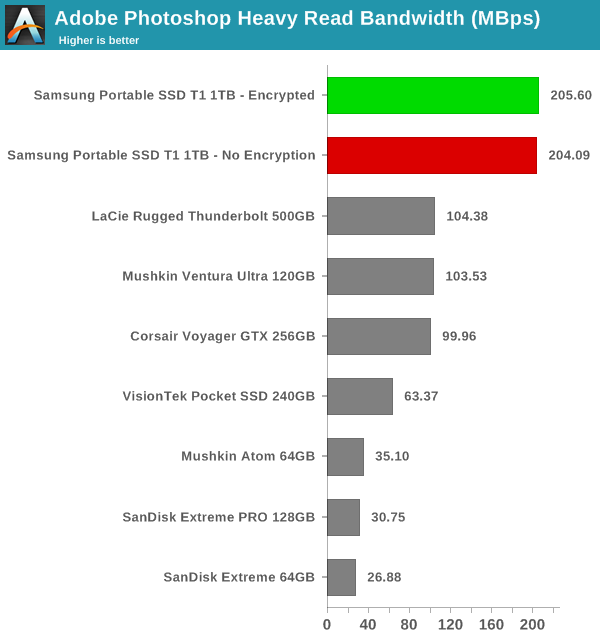

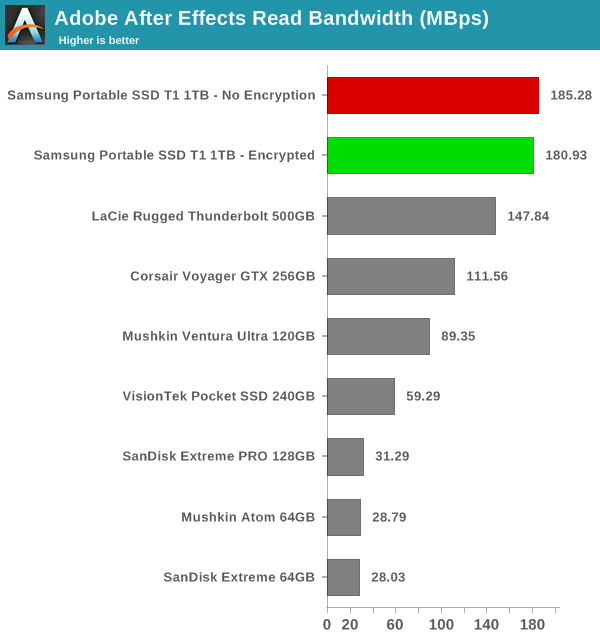
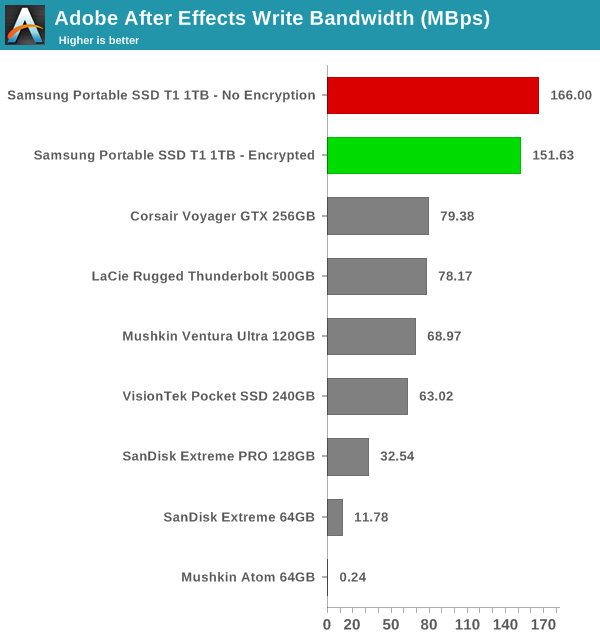
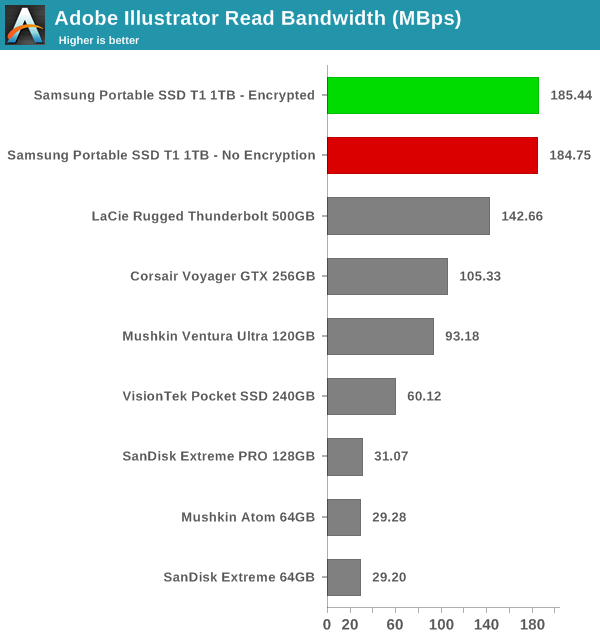

The 1TB Portable SSD T1 manages to win almost all the benchmarks, losing out on a couple of traces to the LaCie Rugged Thunderbolt 500GB version (which, incidentally, carries a Samsung PM851 behind a USB 3.0 - SATA bridge).










68 Comments
View All Comments
mczak - Wednesday, January 21, 2015 - link
If it's just a broken partition table, this should indeed work just fine. It isn't obvious from the article though how this actually works - if the drive needs some special commands to be sent or anything like that this won't do.bill.rookard - Tuesday, January 20, 2015 - link
I'm a bit curious as to the premium price. One wasn't listed, but at .60/GB that comes to around $600 USD for a 1TB drive. Perhaps it's the format itself, but just simply looking on Newegg shows:1) 850 EVO VNAND 1TB 2.5" drive at around $475 USD
2) USB 3.0 2.5" drive enclosure at around $10 USD
That would get us virtually the same performance (if not identical performance) to the T1 at albeit a slightly larger physical size. My question is how many people consider the slightly smaller physical footprint worth the 15-20% increase in price?
Flunk - Tuesday, January 20, 2015 - link
A custom enclosure like this costs more to produce. There is no way that they could sell it for only $10 over the bare drive. Some people prefer to buy pre-assembled drive units and because of that there is a bit of a premium. So yes, there are definitely buyers out there for this.bill.rookard - Tuesday, January 20, 2015 - link
I would certainly agree about the custom enclosure being a little more expensive than your typical 2.5" drive China-built enclosure, but the other thing to remember is that the prices I quoted are also -retail- prices currently available.I'm sure that Newegg isn't paying Samsung $475 for that drive that they're turning around on their site (take off 5-10% for markup and an extra 20% for a 'premium' drive like the 850 pro) and it's probably closer to $350 at wholesale costs. At $350 for wholesale prices, that means the drive itself is probably close to $125-$130 for Samsung to produce.
The drives themselves are very similar in parts (all have controllers, pcb's, NAND chips, etc) and with the ONLY differentiation being the case itself, it's interesting that this drive would retail for more than your average mid-spec'd AMD -system-. While I'm all for being up on the latest technology, IMHO this drive needs to come down on price before people would probably even consider buying it.
jhoff80 - Tuesday, January 20, 2015 - link
I think a more fair comparison would be to an mSATA drive, which is closer to the size of this. Even still, the 1TB 840 mSATA drive is under $500 as well.baii9 - Tuesday, January 20, 2015 - link
And with a Mata/2.5 drive, you can always pop it out to trim if it comes down to it, 500+gb data are not easy to move around for formatting the driveAJSB - Tuesday, January 20, 2015 - link
The real problem here is DATA RETENTION.As soon as drive is disconnected, the NAND cells start to loose charge and they loose much much faster than a HDD...how much time till this drive "implodes" ?
akdj - Tuesday, January 20, 2015 - link
Seriously? First I've heard of an SSD 'implod(es)ing'???NAND is pretty reliable. It's been in most smart phones for a while and I've yet to see an Android or iPhone implode. That said, I've yet to own a Windows phone. Hmmm
andychow - Tuesday, January 20, 2015 - link
According to JEDEC spec the P/E cycle rating is with one-year data retention. So after 6000 P/E cycles the data will still be good for 1 year while the SSD is disconnected.On a drive with just a few P/E cycles, it's likely to be over 10 years of data retention.
This isn't regular tlc nand, this is 32-layer tlc v-nand on a 40nm process.
Regular HDD suffer from kinetic shock and vibrations. This does not.
AJSB - Tuesday, January 20, 2015 - link
That JEDEC DATA refers to what kind of NAND ?SLC, MLC , TLC or V-NAND ?...and with witch lithography ?
As NAND cells go down in size, they got worse in DATA retention....i heard that 15nm will last only weeks removed from a PC (this is not same as PC switched off, because even when switched off, a SSD is still working at low level of energy doing its thing to keep cells charged).
Granted, this uses 40nm and in 3D witch makes it much much more reliable...i read a good article about this V-NAND from SAMSUNG and it's very well designed in its cell structure.
As for HDDs, one thing is 3.5" HDDs another is 2.5" HDDs...2.5"s are designed for Notebooks with special sensors,etc., granted, some more than others, and they can stand a LOT of abuse...i had a Toshiba Notebook long ago and was working w/ it as battery was charging, suddenly i needed to go away and forgot cable of AC/DC brick and stumble on it...the Tosh fled away in the air and hard land in hard floor face done....all this as HDD was working in video editing !
I thought "it's done"...no it wasn't (well, the hinges of LCD didn't like the hard fall) !
The HDD not only wasn't damaged but it didn't lost/corrupt DATA !
Believe me or not...this happened more than once.
Because of this i trust a LOT in 2.5" HDDs of good brands.